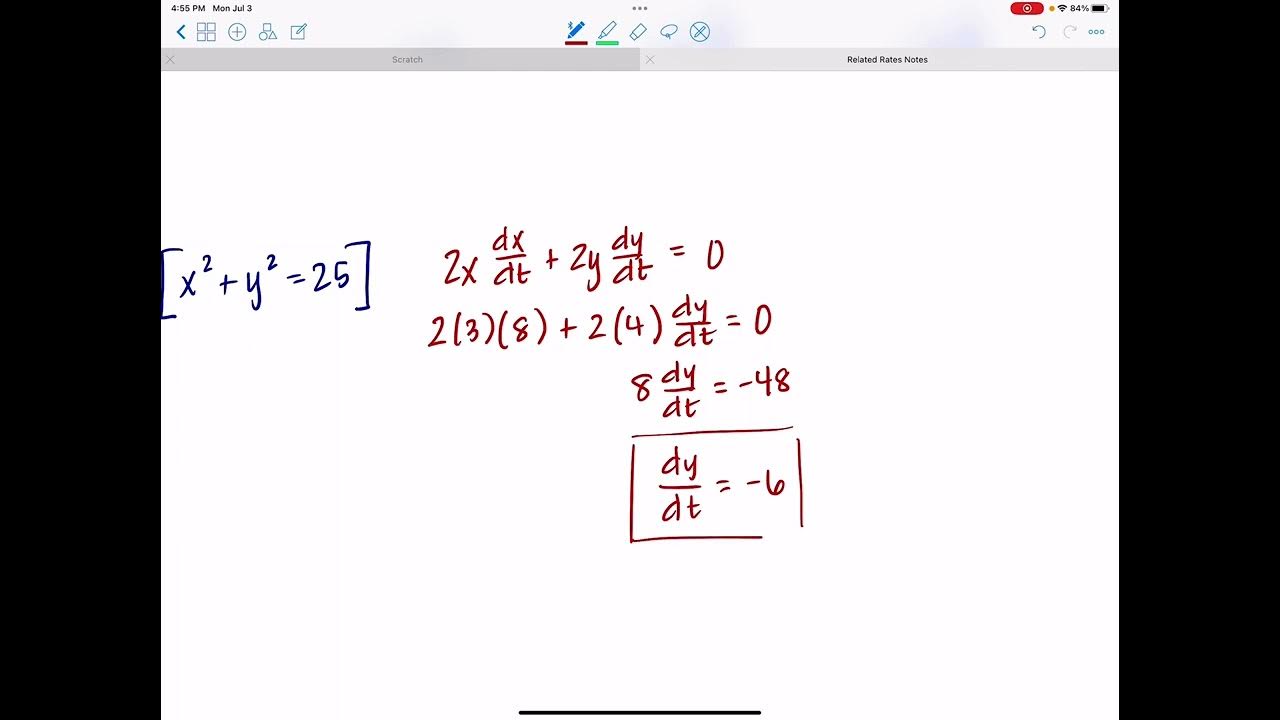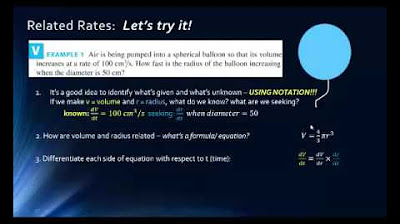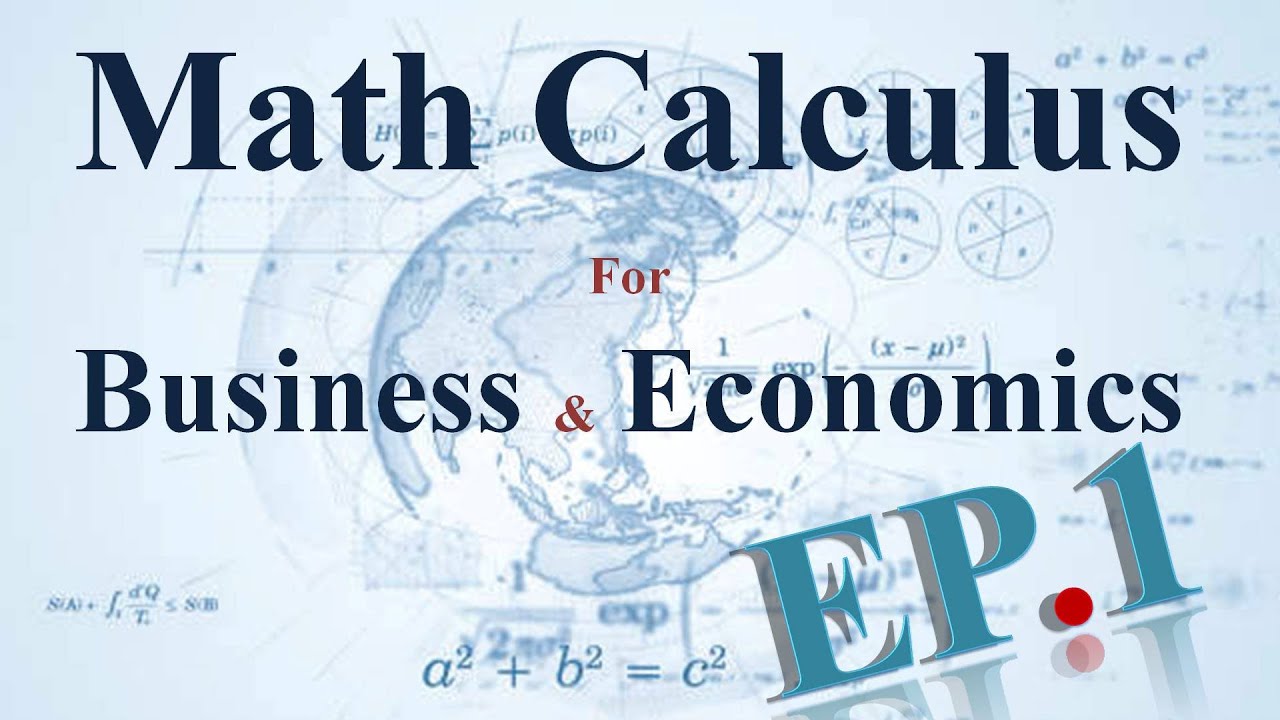Related Rates - Conical Tank, Ladder Angle & Shadow Problem, Circle & Sphere - Calculus
TLDRThis transcript discusses the concept of related rates in calculus, focusing on how to differentiate various equations with respect to time. It covers the power rule and implicit differentiation, using examples such as the changing distance between two points, the rate at which the area and circumference of a circle change, and the rate of a cone's height change. The transcript also includes a problem-solving approach for related rate problems, emphasizing the importance of identifying the correct variables and applying the appropriate calculus rules.
Takeaways
- 📚 The concept of derivatives is introduced as a fundamental part of calculus, specifically focusing on the rate of change with respect to a variable.
- 🧮 Power rule is applied to differentiate functions like y^3 and r^4, emphasizing the pattern of differentiation with respect to different variables.
- 📈 The importance of understanding the relationship between variables when differentiating with respect to another variable is highlighted.
- 🌟 The Pythagorean theorem is used to solve related rate problems, such as finding the rate of change of z when x and y are given.
- 🔄 The process of implicit differentiation is explained, which is crucial for finding rates of change in related rate problems.
- 📊 Examples of related rate problems are provided, including the rate of change of distance between points and the rate of change of the area of a circle with a decreasing radius.
- 🔢 The use of special right triangles (3-4-5, 5-12-13, etc.) is emphasized for simplifying calculations in related rate problems.
- 📚 The differentiation of equations involving functions of multiple variables is discussed, such as differentiating x^3 with respect to y.
- 🌐 The script touches on the application of calculus in real-world scenarios, like calculating the rate of change of the distance between a moving point and the origin.
- 📈 The process of rationalizing the denominator is explained in the context of finding dz/dt, which is crucial for understanding the rate of change.
- 🔍 The script concludes with a comprehensive example involving a baseball diamond, showcasing the application of related rates in a practical scenario.
Q & A
What is the derivative with respect to x of y to the third power?
-The derivative of y to the third power with respect to x is 3y squared, using the power rule.
How do you differentiate a variable with respect to another variable?
-To differentiate a variable with respect to another variable, you use the power rule if it's a simple power function. For more complex functions, you may need to use implicit differentiation or other calculus techniques.
What is the pattern for differentiating with respect to different variables?
-The pattern is that when you differentiate with respect to x, you get d/dx, and when you differentiate with respect to y, you get d/dy. This pattern applies to the variables involved in the function.
How do you find the derivative of x cubed with respect to x?
-The derivative of x cubed with respect to x is 3x squared, which simplifies to 3x^2 when the dx^2 term cancels out.
What is the process for solving related rate problems?
-For solving related rate problems, you first differentiate the given equation with respect to time, then substitute the known values and solve for the unknown derivative of interest.
How do you find the rate of change of distance between two points in a related rate problem?
-You first find the equation relating the two points, then differentiate both sides of the equation with respect to time to find the rate of change of the distance.
What is the derivative of y to the fifth power with respect to time?
-The derivative of y to the fifth power with respect to time is 5y to the fourth power times dy/dt.
How do you find the derivative of an r to the fourth power with respect to x?
-The derivative of r to the fourth power with respect to x is 4r cubed times dr/dx.
What is the derivative of s to the fifth power with respect to y?
-The derivative of s to the fifth power with respect to y is 5s to the fourth power times ds/dy.
What is the rate of change of the area of a circle when its radius is decreasing at a rate of four centimeters per minute?
-The rate of change of the area of a circle when its radius is decreasing at a rate of four centimeters per minute is negative 64π (negative sixty-four pi) square centimeters per minute.
Outlines
📚 Introduction to Related Rates and Derivatives
This paragraph introduces the concept of related rates and derivatives in calculus. It begins with a discussion on derivatives, specifically focusing on the power rule for differentiation. The explanation includes examples of finding derivatives with respect to different variables, such as the derivative of y^3 with respect to x, and r^4 with respect to x. The paragraph emphasizes understanding the pattern of differentiation and the resulting derivatives. It then transitions into related rate problems, where the focus is on differentiating equations with respect to time. The first problem involves finding the rate of change of z given x, y, dx/dt, and dy/dt. The paragraph concludes with a practical example of finding the derivative of an equation involving x, y, and z, and how it relates to the Pythagorean theorem.
🔄 Solving for Rates of Change in Various Scenarios
This paragraph delves into solving for rates of change in different scenarios using related rates. It starts with an example of finding the rate of change of the distance between the origin and a moving point on a graph. The paragraph explains the process of using implicit differentiation and plugging in given values to find the rate of change, denoted as dz/dt. The discussion then moves to a problem involving the radius of a circle decreasing at a certain rate, and how this affects the area and circumference of the circle. The paragraph also covers how to find the rate of change of the surface area of a snowball and the diameter of a sphere, highlighting the importance of understanding the units involved in the calculations.
📈 Analyzing Changes in Geometric Shapes
This paragraph focuses on analyzing changes in geometric shapes using related rates. It begins with a problem involving the side length of a square increasing at a certain rate and how this affects the area and perimeter of the square. The paragraph then presents a problem about a balloon being inflated and how the volume change rate is related to the radius change rate. It also discusses the increase in surface area and volume of a cube with respect to the increase in its side length. The paragraph concludes with a problem involving a ladder leaning against a wall and how the rate of change of its position and the area of the triangle formed can be calculated.
🌐 Applying Related Rates to Real-World Problems
This paragraph applies the concept of related rates to solve real-world problems. It starts with a scenario of a man walking away from a pole and how the tip of his shadow and the length of his shadow change. The paragraph then moves on to a problem involving a spotlight on the ground and a man walking towards a building, calculating how the length of his shadow on the building changes. The discussion includes setting up proportions and using similar triangles to find the rates of change. The paragraph also covers a problem involving two cars moving in different directions and how the rate of change of the distance between them can be calculated. The final problem involves two ships moving apart and how the rate of change of their distance is determined.
🚀 Calculating Rates of Change in Motion
This paragraph discusses the calculation of rates of change in various motion scenarios. It begins with an example of an airplane traveling horizontally and how the distance between the plane and a radar station changes over time. The paragraph then describes how to find the rate at which the angle between the ground and an observer's line of sight to an airplane changes. It also covers a baseball player running towards first base and how the distance between him and second base changes. The paragraph concludes with a problem involving a trough filled with water and how the water level changes over time. The discussion includes using trigonometric functions, Pythagorean theorem, and differentiation to solve these problems.
Mindmap
Keywords
💡Derivatives
💡Related Rates
💡Implicit Differentiation
💡Pythagorean Theorem
💡Chain Rule
💡Trigonometry
💡Volume
💡Rate of Change
💡Power Rule
💡Dimensional Analysis
Highlights
The introduction of related rates problems and their application in calculus.
Explaining the concept of derivatives and their use in solving related rates problems.
The power rule application in differentiation, including various examples with respect to x and y.
The importance of understanding the pattern of differentiation with respect to different variables.
Working through the first related rates problem involving z squared equals x squared plus y squared with given dx/dt and dy/dt.
The application of the Pythagorean theorem in solving related rates problems.
The process of finding dz/dt using implicit differentiation and plugging in known values.
The explanation of how to find the rate of change of distance between a moving point and the origin using the equation z squared equals x squared plus y squared.
The method of finding dx/dt by differentiating the equation y equals x squared plus one with respect to time.
The use of dimensional analysis to determine the units for dA/dt when the radius of a circle is decreasing.
The process of finding the rate of change of the diameter of a snowball with respect to time using the surface area formula for a sphere.
The method of determining the rate of change of the area and perimeter of a square when the side length increases at a certain rate.
The solution to the problem of how fast the radius of a balloon is changing when inflated with gas at a certain rate.
The application of the volume formula for a cube to find the rate of change of surface area and volume with respect to the side length's increase.
The detailed explanation of the ladder problem involving rates of change for x, y, and the area of the triangle formed.
The approach to find the rate at which the height of a conical pile of gravel is changing given the rate of dumping from a conveyor belt.
The solution to the problem of the inverted conical tank with water leaking out and the calculation of the net rate of water flow.
The explanation of how the rate of the tip of a shadow moving can be found using similar triangles and the rate of change of the shadow's length.
Transcripts
Browse More Related Video
5.0 / 5 (0 votes)
Thanks for rating:





